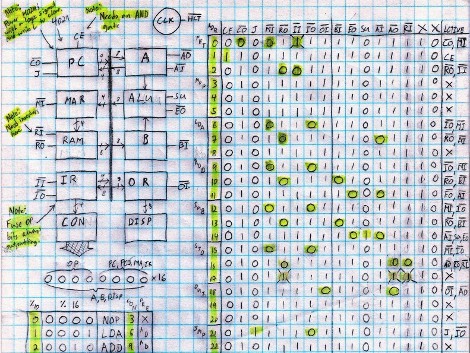
[Kyle] has been hard at working building an 8-bit computer from the ground up. He’s using a set of logic IC’s for the various components, and some NVRAM chips to store the control words. What you see above is the roadmap for his instruction set. He’s just started writing them to the chips, making the job easier by building an Arduino-based programmer.
We’ve enjoyed watching [Quinn Dunki’s] progress with her Z80 6502-based PC build which started on a breadboard in much the same way but has come a long way since those humble beginnings. Recently we also looked in on a 4-bit computer that is using discrete components. But [Kyle’s] take on the challenge falls somewhere in between the two.
The gist of his design can be found in one of his earlier post. He’s got a ring counter which starts by clearing the address register. It then loads the NVRAM address of the next instruction which is then executed on the subsequent count. It seems the build still has some way to go so make sure to keep your eye out for updates.
[via Reddit]















Uhm… Are you sure the Veronica is based of the Z80? I’m pretty sure it’s the 6502.
^ yes, “When it came time to try out some old-school computing [Quinn Dunki] grabbed a 6502 processor and got to work.” I wouldn’t normally troll like this, but it wasn’t mentioned in the post that this one linked to, nor in the one linked to by that one, and that one doesn’t have a link to the previous iteration. To find out, you’d have to go all the way back to the first post(s).
I’d like to see a modernized version of the paperclip computer.
http://lab16.wordpress.com/2009/01/29/paperclip-computer/
There’s a link to the instructions from 1967. To construct it one had to build *everything* from scratch except the light bulbs.
The Binary Coded Decimal switches made of bits of metal and wood thread spools are amazing, so is the magnetic core memory made from paper clips.
The finished product is more of a manually operated computer because doing things like shifting data from the program drum to memory uses switches. It should be possible to rig up relays or solenoid operated switches and a trigger wheel on the program drum to automate that, and same for other operations.
The intent of the project was to demonstrate step by step how a digital computer works.
Building it with modern parts like off the shelf BCD switches, bulb sockets etc. and adding automation would be a fun project – then expand on it.
Think of it as the “stone knives and bear skins” level of computers. :)
http://lab16.wordpress.com/2009/01/29/paperclip-computer/
No longer available….????
Great stuff! :D
Nice. How about doing a DCPU-16 next? =D